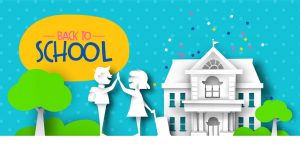Strategize Now to Set up a Successful School Year

Gather your strength–it’s time to set the alarms, make the lunches and buy the supplies. School is starting again. How can you avoid frustration and arguments to create the smooth transition that everybody wants? By relying on Compassion, Collaboration and Consistency, you can work with your child or teen to set a positive tone for the year.
Many kids with ADHD feel mixed about the return to school. While they may be excited to see their friends, they often dread the return to academics, waking up early and the responsibility of homework. If they struggled last year, they may worry about repeating the same challenges or facing new, unexpected ones.
- Before talking with them, take a few moments to summon your Compassion. Reflect on some of the highs and lows for your son or daughter from last year. How did they meet those challenges? What types of support from you or their teachers was helpful? Jot down some of your ideas. Before moving forward, remember that kids with ADHD are doing the best they can with the limited resources available to them in a given moment. They need you to understand this before approaching any plan for this year.
 2. Make a time to talk with your child or teen about this upcoming year so you can Collaborate on a plan for success. Ask them to recall successes and challenges and, if they can’t think of anything, offer some reminders from your notes. Together, make a list of useful supports–anything from setting several alarms in the morning to emailing a copy of homework in case they forget to turn it in to breaking up study periods with timed breaks. Then, make a list of common distractions or obstacles you both anticipate could arise this year.
2. Make a time to talk with your child or teen about this upcoming year so you can Collaborate on a plan for success. Ask them to recall successes and challenges and, if they can’t think of anything, offer some reminders from your notes. Together, make a list of useful supports–anything from setting several alarms in the morning to emailing a copy of homework in case they forget to turn it in to breaking up study periods with timed breaks. Then, make a list of common distractions or obstacles you both anticipate could arise this year.

3. Evaluate both your expectations for the year and theirs. Consistency relies on regular efforting, not perfection. We want to nurture resiliency by acknowledging how kids with ADHD are trying to do stuff and improve themselves. You’re looking for progress, not perfection. There are three types of goals to consider: easily attainable (things they can definitely achieve or have already been doing), working on/within reach (things they accomplish but require supervision or help) and mostly reach goals (things that are sporadically achieved). For now focus on one easily attainable goal and one working on/within reach goal. You can expand this list as the year progresses.  By keeping things simple, you increase the chance for success and we want children and teens to feel as positive as possible right now. Feeling successful early in the year has a snowball effect: they notice their competence and want to build on it. Using Compassion, Collaboration and Consistency, you’ll create a strong foundation for a great year!
By keeping things simple, you increase the chance for success and we want children and teens to feel as positive as possible right now. Feeling successful early in the year has a snowball effect: they notice their competence and want to build on it. Using Compassion, Collaboration and Consistency, you’ll create a strong foundation for a great year!
